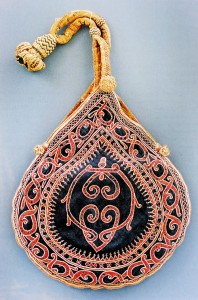The betel bag of many parts and hues
Utility items were ornamented to such a high degree in the Udarata kingdom that many became objects of art. One such item is the betel bag, known as ‘kurapayiya’. P.H.D.H. de Silva says ‘the Udarata betel bag ‘surpasses the betel bags of South and Southeast Asia, in its construction, use of traditional motifs and craftsmanship.’

Pictures courtesy ‘Traditional betel bags’ published by the National Museum
These betel bags were made of cotton, usually dyed blue or red and lined with undyed calico. The cloth was usually homespun dark blue or white cotton. The bags came in different sizes. They were mainly oval shaped, but there were also bowl, heart, square and pyramid shaped bags. Each bag had, in addition to its capacious main cavity, several other pockets including a secret pocket. Some bags had woven designs. One had an all-over diamond pattern weave in red and blue. Another had a diagonal centipede weave. Betel bags used by farmers and those working out of doors were made of grasses such as ‘gallehe’.
The bags owned by the elite had to hold large quantities of betel leaves to be given as gifts or presented on formal occasions such as invitations to a wedding. These bags were also carried in processions and at weddings. Valuables, including money, were put into the secret pocket when nobles went on long journeys. One bag, from Magalakaduwala, Galgamuwa, had been used for carrying official documents.
The bags of the rich were carried by servants, but they could be inspected by others at important functions and ceremonies, so they had to look good. They were richly decorated with beautiful embroidery.. The exterior on both sides of the bag usually had exquisite embroidery in traditional Kandyan designs in blue, red and white, with occasionally, an original design. Both sides usually had the same design, but, occasionally again, the bag had two separate designs on the two sides.
Udarata embroidery is shown at its best in the betel bag, said de Silva. The standard design consisted of a single large flower in the middle, and a series of borders around it. The flower could be a four petal one or a multi petalled lotus. The border had ‘liya vela’, ‘kundirakkan’, ‘havadiya’, and ‘pala peti ’, ‘Bo pat’ and diamond designs. Some bags had four and five borders of varying sizes along the edge. In one bag practically the whole surface was embroidered with borders. The various borders were separated from each other by three rows of chain stitches.
Some bags were heavily embroidered. One outstanding bag, acquired by the Colombo Museum around 1892, was fully embroidered. It has a floral design on one side, with a pair of long beaked birds perching on the flowers, and a pair of decorative peacocks, back to back, at the bottom. The other side had a design of flowers, leaves, buds and eight small birds, twined together, as its central motif. Two swans faced each other at the top with two hansa puttava and two small birds at the bottom. There were four decorative borders all round, each separated from the other by a row of chain stitch in white thread.
The betel bag had prominent handles consisting of paired right and left arms. The arm of each handle consisted of two to four plaited cords or woven bands, held together in the middle, with a small ball. There is an enormous variety in the way these cords are arranged and combined. In one bag, each handle contained 5 to 7 cords. Another bag had four handles. The handles were gathered together at the top by a hard ball (vegedi borale) topped with a tassel (pohottuwa). The vegedi borale had a ‘diya rela’ (wave) pattern in several rows of red, blue and white threads.
The handles in one square betel bag had cords plaited in diya wela pattern in red blue and white threads. They were attached to a double cloth resulting in four small side pockets and a spacious central pouch. It had just one motif in the centre of each section. Another small four cornered square bag, pyramid shaped had four long handles, of two bands, in zig zag design of red and blue and white threads. The inner band of each handle was attached to a double cloth, giving a central pocket and eight side pockets. There was an embroidered design on the bottom of the bag and motifs on the sides.
(The writings of Ethel Coomaraswamy P.H.D.H. de Silva and Florence Ratwatte were used for this essay)


